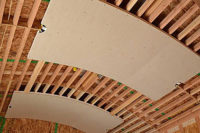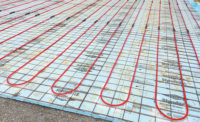
I’ve always been fascinated by how some highly skilled hydronic heating pros can assemble thousands of individual components into a smoothly operating, custom-designed system. From microprocessor-controlled heat sources to specialized circulators, to a knowledge of flooring material for radiant-heating applications, modern hydronic pros need a wide spectrum of expertise to pull this all together.
The share of the U.S. heating market that hydronics claims hasn’t changed much over the last two decades. Sure, there are locations where market percentages are relatively high - the ski areas in Colorado come to mind. Still, the vast majority of those building homes in the United States over the last two decades didnotdecide to install hydronic heating.
We could spend hours debating the underlying causes of this reality. Instead, why not look forward? As I see it, the possibility forone of the broadest expansions of the North American hydronics markets is at our doorstep.
Big talk, you say. After all, it’s easy for writers to spread continued optimism. They aren’t out there in the trenches facing tight credit, increasing material prices, and a constantly expanding cyber marketplace where hardware is sold to anyone with a credit card and Internet connection.
So why the optimism? Let’s start with a few key words. If you’re like me, you have a stack of trade magazines piled up in your office for eventual reading. Look at the stories on the covers of those magazines over the last two years. Chances are you’ll see words like green, sustainable, renewable, conservation, solar, geothermal, and of course, efficiency.
Now comes the question: What HVAC technologyunifiesall these words and the concepts they represent? Hint: it starts with the same letter as H2O.
Hydronics technology is the glue that holds almost all thermally based renewable energy systems together.
Looking Beyond the Heat Source
Take a look at a solar thermal system for domestic water heating, or a combisystem that supplies both space heating and domestic hot water. What hardware do you see? Circulator(s), tubing, venting, valves, air separators, expansion tanks and so forth. This is all hydronic hardware. The “new” components would be the collectors and perhaps a storage tank that’s slightly different from a standard indirect water heater.Next, look at the hardware in a geothermal heat pump system: flexible tubing buried in the ground, rigid tubing, circulators, valves, expansion tanks, etc. Sure, the heat pump is a new heat source, and fusion welding of polyethylene pipe is a new skill that will probably take most technicians about an hour to master, but in the end, the success or failure of a geothermal heat pump system again depends on doing the hydronics correctly.
The same can be said about solid fuel boilers, micro combined heat and power (MCHP) units, and small scale gas-fired absorption chillers. The lure of these contemporary systems is the heat-producing equipment, but their backbone is the proper application of hydronics technology.
It Wasn't Covered...
Imagine an enthusiastic and technically competent young man or woman who wants to be part of the next generation of renewable energy professionals. He or she attends one of many currently available intensive training programs to learn how to install solar thermal systems. While there they learn about solar pathfinders, proper placement of solar collectors, how to properly fasten those collectors to a roof, how to connect the collectors to the storage tank, and how the controller that operates the solar array circulator operates.After a few months of successfully installing what are now mostly “plug and play” solar DHW systems, an opportunity arises to design and install a solar combisystem that links a larger storage tank, along with a boiler, to a floor-heating system.
Somewhere along the way this solar energy specialist heard that radiant floor-heating systems operate at low water temperatures, and thus are well-matched to solar heat input. Since there wasn’t time to cover the specifics of radiant floor-heating, the Internet-savvy technician goes online to one of many sites where the parts and pieces of radiant panel heating systems are sold. They read some do-it-yourself instructions and purchase the components needed to staple 1/2-inch PEX tubing directly to the bottom of the subfloor and cover it up with a layer of bubble foil insulation. This is the infamous “plateless staple-up” approach that has tested the reputation and the liability coverage of its share of installers. But remember, the solar specialist hasn’t been aware of such issues. The solar tech installs the materials just like the online instructions showed.
Fast forward to some cold but sunny days the next winter. The auxiliary boiler in the combisystem runs most of the time, even when the sun is out. The storage tank only gets lukewarm, and the fuel savings anticipated by having the solar collectors just aren’t appearing.
Some of you probably know what’s happening: To release heat at the rate the building needs it on a cold day, the water in a plateless staple-up radiant floor panel may require water temperatures of 160° or 170° F. Although it’s possible for some collectors to reach these temperatures on sunny winter days, the amount of heat they can transfer to the system under such conditions is very limited. In short, the plateless staple-up floor heating was just not a good match for the operating characteristics of the solar collectors.
So why would a technically competent solar technician end up in this situation? Because he or she didn’t have a broad knowledge of hydronic heat emitters and distribution systems. This is the “glue.”
Although some of us may think subjects like radiant panel heating are now well understood by our industry, there is a whole generation of eager renewable energy enthusiasts out there for whom such information is brand new.
I’ve seen this when giving seminars on modern hydronics to groups of individuals specializing in renewable energy and building science. Although these seminars describe how the solar subsystems operate, questions deal with the specifics of radiant heating, smart circulators, distribution system design, and other hydronic essentials. These are the subjects that are typically not taught, at least not in detail, at most currently offered solar technology workshops. These are also the issues that make or break the performance of any solar combisystems. Ultimately they will also play a part in determining if the currently strong interest in renewable energy heat sources is truly “sustainable.”
The ability to unify renewable heat generation with highly efficient heat distribution and superior uncompromising comfort is a unique benefit of hydronics. It’s also why I think hydronics is poised for strong future growth. However, our industry needs to continually communicate this message to the masses.
The Radiant Panel Association has recognized this and is seizing upon the opportunity. At its annual convention in May, Executive Director Ted Lowe laid out a vision for the future of the organization as an envelope to address not only radiant panel heating, but the integration of renewable energy heat sources along with other contemporary HVAC technologies - the unifying element again being hydronics. This is the right message at the right time.
Manufacturers are also in a position to shape the future of hydronics, but it needs to come in the form of “solutions” rather than simply hardware. The market in which a small number of highly skilled hydronic heating pros earn their living by piecing thousands of components into a highly customized system is shrinking. The opportunity for greater numbers of technicians to install highly pre-engineered solutions that include both conventional and appropriate renewable energy heat sources is growing.
What is your firm doing to promote hydronics as the unifying element of renewable energy systems?




